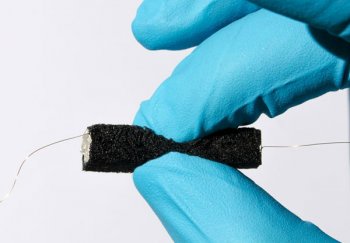Researchers have created a new type of high-capacity storage device that's both elastic and super-strong, and it will let us store way more electricity in much smaller spaces.
The foam-like batteries and supercapacitors were made using an aerogel material taken from tree fibres, and unlike today's batteries, could be used to create 3D structures, and line flexible and odd-shaped materials such as clothing or the bodies of vehicles.
"There are limits to how thin a battery can be, but that becomes less relevant in 3D," lead researcher Max Hamedi, from the KTH Royal Institute of Technology in Sweden and Stanford University in the US, said in a press release. "We are no longer restricted to two dimensions. We can build in three dimensions, enabling us to fit more electronics in a smaller space."
Publishing their results in the journal Nature Communications, the announcement comes just a few days after another group of researchers made a biodegradable computer chip out of wood. "It is possible to make incredible materials from trees and cellulose," said Hamedi.
The batteries and supercapacitors - which are devices that store and release power much faster than batteries - were made out of a wood-based aerogel. To create this aerogel, the team first broke down cellulose, the fibre found in trees, making it around one million times thinner.
They then dissolved this nanocellulose and freeze-dried it, so that the moisture evaporates without the material ever going through a liquid state. The molecules in the material are then stabilised, so that it does not collapse.
"The result is a material that is both strong, light and soft," said Hamedi. "The material resembles foam in a mattress, though it is a little harder, lighter and more porous. You can touch it without it breaking."
This aerogel is then coated with a special ink that conducts electricity within the aerogel, giving it the electronic properties that a battery requires.
Using the material as a base, the team carefully engineered a 3D supercapacitor with carbon nanotube electrodes, and a hybrid battery. Both of them were fully functional even at 75 percent compression, and the supercapacitor worked stably for 400 charge cycles. "Our results demonstrate that layer-by-layer self-assembly inside aerogels is a rapid, precise and scalable route for building high-surface-area 3D thin-film devices," the authors write.
While in the past it was assumed that 3D, porous batteries such as this one would not be practical or have much storage capacity, Hamedi explains that it actually offers more functionality. He compares the material to a pair of human lungs, which, if unfurled, could cover a football field. "You can press it as much as you want. While flexible and stretchable electronics already exist, the insensitivity to shock and impact are somewhat new," he added.
Of course it's very early days and researchers still need to scale these devices up and show that they work in electronic systems, but in the future they could be used to store electricity in places that current batteries can't, and could help electric cars travel further on a single charge, thanks to their light and bendy structure.
They could also line clothing, helping to develop wearable electronics, such as a T-shirt that's capable of charging your iPhone. So we're pretty excited to see what the researchers do with the material next.
